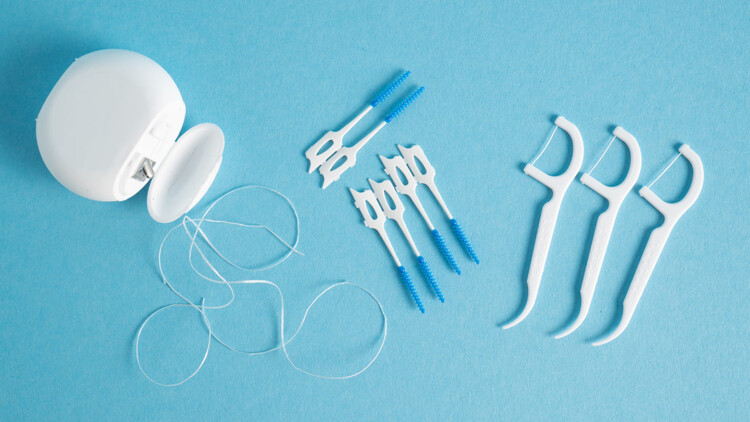Flossing may seem like a simple task at first glance, but since it plays a crucial role in oral health, it must be done with specific techniques and conditions. Dental floss comes in various types, such as floss picks, water flossers, and threaders, each with its own advantages and disadvantages. Flossing, alongside professional teeth cleaning, removes all plaque and debris from your teeth, and you can’t achieve complete cleanliness for your teeth and gums only by brushing.
In this article, you’ll learn about the different types of dental floss and their features, how to floss properly, and the benefits of flossing for oral hygiene and health.
Step-by-Step Guide to Mastering Proper Flossing
Flossing is a critical part of oral hygiene that helps remove food particles and plaque from between teeth. Contrary to common belief, brushing alone does not ensure optimal oral health; rather, a combination of flossing, brushing, healthy eating habits, and regular family dentistry visits contributes to it. Mastering proper flossing techniques can prevent gum disease and tooth decay. Below, we’ve outlined how to floss properly step by step:
- Select the Appropriate Floss: Choose dental floss that suits your needs, such as waxed or unwaxed, depending on your preference.
- Take the Correct Length: Take about 45 centimeters of dental floss to ensure you have enough for effective cleaning.
- Wrap the Floss: Wind most of the floss around the middle finger of one hand and the remainder around the middle finger of the other hand, leaving about 2.5 to 5 centimeters of floss between your hands for cleaning.
- Hold the Floss: Grip the floss firmly between your thumbs and index fingers, keeping a small section taut for use. Position your fingers close to your teeth for better control.
- Guide the Floss: Gently slide the floss between your teeth using a back-and-forth motion. Avoid snapping the floss against your gums to prevent irritation.
- Curve and Slide: Curve the floss into a C shape around each tooth and slide it up and down, extending slightly below the gumline. Use a clean section of floss for each tooth.
- Repeat: Move to the next tooth, wind a fresh section of floss around your fingers, and repeat the process until all teeth are cleaned.
- Rinse: Rinse your mouth with water or mouthwash to remove any loosened particles.
For a better understanding of how to floss properly, watch this instructional video:

Note: If flossing causes gum bleeding, continue with a gentler approach. Your gums should improve within one to two weeks. If bleeding persists, consult a dentist promptly to explore restorative dentistry options.
Choosing the Right Floss and Tools for Your Needs
When we talk about how to floss properly, the first thing to consider is selecting the appropriate flossing tools. Various tools are available for this purpose, each with its own unique features and suited for specific conditions. Below, you’ll learn about the different flossing tools:
- Floss Picks: These are small plastic tools with a short piece of dental floss attached. Floss picks are particularly convenient for use on the go.
- Water Flossers: These devices use a stream of pressurized water to remove plaque and food particles. Water flossers are ideal for individuals with sensitive gums or orthodontic appliances. You can read more about comparing waterpik vs flossing here.
- Floss Threaders: These are loop-shaped tools designed to guide dental floss under bridges and orthodontic brackets.
Types of Dental Floss
While various tools are available for flossing, the most common interdental cleaning tool remains dental floss, which comes in several types. The table below outlines the different types of dental floss and their characteristics:
| Type of Floss | Features | Suitable For |
| Waxed Floss | High glide between closely spaced teeth, less likely to shred | Closely spaced teeth |
| Unwaxed Floss | Thinner, greater cleaning effect, more prone to shredding | Closely spaced or normal teeth |
| Dental Tape | Wider and flatter than standard floss | Large gaps between teeth |
| Super Floss | Stiff end with a spongy section | Orthodontics, bridges, large gaps |

Ultimately, choosing the right dental floss or tool depends on your specific needs and the condition of your teeth. For example, waxed floss or dental tape is ideal for closely spaced teeth, while super floss or threaders make cleaning easier for those with orthodontics, bridges, or implants. Regardless of the tool you choose, regular flossing, combined with brushing and periodic dental checkups, is essential for maintaining gum health and preventing tooth decay.
For more information on selecting the right flossing tools, visit Top Oral Hygiene Tools.
Common Flossing Mistakes and How to Fix Them
Flossing is essential for oral health. Dental plaque is removed by daily flossing alongside brushing, and if plaque is not removed, it hardens into tartar. However, many people make mistakes while flossing that reduce its effectiveness. Identifying and correcting these errors can improve your dental hygiene. The most common flossing mistakes and their solutions are:
Infrequent Flossing
If you care about your oral health, you should floss at least once a day. Neglecting flossing or doing it irregularly leads to plaque and tartar buildup, resulting in gum and dental issues.
Flossing Too Aggressively
Snapping the floss against your teeth and gums can cause irritation and bleeding. Instead, guide the floss gently between teeth with a back-and-forth motion. As emphasized by reputable sources like the NIDCR, “Another common mistake is forcing the floss between teeth. This can cause pain and damage the delicate tissue between teeth.”

Not Cleaning Below the Gumline
If you only clean the sides of your teeth and neglect below the gumline, plaque and food particles won’t be fully removed. Curve the floss into a C shape around each tooth and slide it slightly below the gumline for thorough cleaning.
Reusing Dirty Floss
Use a fresh section of floss for each tooth. Reusing the same section transfers bacteria and reduces cleaning effectiveness.
Flossing Too Quickly
Take your time when flossing and avoid rushing. Hurrying may leave some areas uncleaned. Flossing should take at least one to two minutes.
Using the Wrong Amount of Floss
The ideal floss length is about 45 centimeters. Wrap most of it around one finger and the rest around another for better control. Using floss that’s too short or too long makes it harder to manage.
Achieve a Healthier Smile with Proper Flossing
Don’t let plaque buildup harm your teeth and gums. At Pape Dental Centre, our experts guide you in mastering flossing techniques for lasting oral health.
Schedule your dental checkup today to ensure a cleaner, brighter smile.
Why Flossing Matters for Your Oral Health
Many people are unaware of the critical role flossing plays in oral hygiene and often skip it. According to statistics published by Statistics Canada, in 2023-2024, only 30% of Canadians over the age of 12 flossed at least five times a week, while 17% did not floss at all.
Dentistry studies show that brushing alone does not clean all tooth surfaces, making flossing essential for complete oral care. Below, you’ll learn more about the benefits of flossing.
Boosting Gum Health and Reducing Inflammation
Flossing offers significant benefits for improving gum health and reducing inflammation by removing plaque from between teeth and below the gumline. Plaque buildup can lead to gum irritation and gingivitis, the initial stage of gum disease characterized by swelling and bleeding. By eliminating irritants such as food particles and bacteria, flossing reduces gum pain and inflammation, helping you maintain healthy gums.
Read more: Gingivitis: Causes, Symptoms, and Treatment Options

Preventing Tooth Decay and Plaque Buildup
Tooth decay is another common oral health issue that flossing helps prevent. Plaque, a sticky bacterial film, can harden into yellow or brown tartar, also known as calculus. Tartar is a primary cause of tooth decay and gum problems. Flossing removes this plaque effectively.
Moreover, flossing reaches areas inaccessible to a toothbrush, preventing acid production by hidden bacteria, enamel erosion, and cavity formation.
Start Flossing Today for a Healthier Smile
Regular flossing is one of the simplest and most effective ways to maintain healthy teeth and gums, yet many people overlook it. You should understand that brushing alone does not achieve complete oral hygiene, and flossing at least once a day is essential. Using the correct technique and choosing the appropriate floss and tools significantly impacts the results. By flossing regularly, you make a low-cost investment with invaluable, lifelong benefits for your oral health.
If you haven’t yet incorporated flossing into your daily routine, it’s time to schedule a professional cleaning and checkup with Pape Dental Centre. Our expert team is ready to guide you in maintaining optimal oral health.
FAQ
What is the most effective method of flossing?
To floss effectively, gently move the floss between your teeth, curve it into a C shape around each tooth, and slide it up and down. Use a clean section of floss for each tooth.
How do I tell if I’m flossing correctly?
If your gums remain healthy, slightly pink, and do not bleed after flossing, and the spaces between your teeth are thoroughly clean, you’re flossing correctly.
Are you supposed to go deep when flossing?
No, never apply pressure to your gums, as this can cause irritation and bleeding. Gently guide the floss slightly below the gumline.
Should you touch the gums when flossing?
Yes, the floss should gently touch the gumline to remove plaque effectively, but this must be done carefully without applying pressure.
Share your thoughts and experiences with flossing in the comments below; how has it improved your oral hygiene, or what challenges do you face?






